By Jeffrey A. Rendall, Photos By Jeffrey A. Rendall
WILLIAMSBURG, VA -- Jeff Winters, Head Golf Professional at the Golden Horseshoe Golf Club, said “We have a tremendous golf course here on the Green Course,” then paused. “But we still can’t get the respect that the Gold Course does.” After seeing both, one thing’s for sure -- the Green course is certainly no ugly stepsister. In fact, the Rees Jones designed Green layout is a lot closer to a ‘Cinderella’ than you might expect.
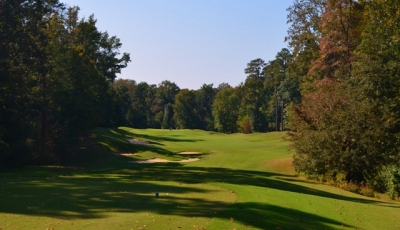 |
| You might want to club down off the tee of the par four 3rd hole to make sure you have a flat lie on your second shot on this short, relatively narrow hole. |
That’s no knock against its older relative, the Gold Course, which is quite a beauty in its own right. And just because the Green Course may be getting its share of ‘princely’ attention these days doesn’t mean the Gold is an evil stepmother, either.
The Horseshoe’s Director of Golf, Glen Byrnes, says the Green Course was built in the early nineties to help accommodate Colonial Williamsburg’s growing convention and meetings business, and is designed in a style where large groups can enjoy the beauty of its natural surroundings without the typical difficulties that sometimes hold up gatherings of ‘resort’ players on a golf course – like forced carries or excessive hazards.
Perhaps the Green Course’s ‘lesser’ reputation, or lack of critical acknowledgement, stems from its relative youth in the classic golf sense. While the Gold Course is about to celebrate its 50th anniversary in 2013, the Green’s been around for ‘only’ a little over twenty years. The Gold also boasts the name Robert Trent Jones as its designer… but then again, the Green offers Trent Jones’ son Rees as its mastermind. No step down in class there.
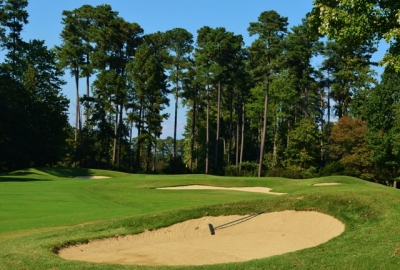 |
| The par four 13th hole is not particularly long or difficult -- but you still cannot take it lightly. |
Because the courses lie adjacent to each other (though you can’t really see much of one from the other), the Golden Horseshoe might very well have the most potent collection of father-son golf designs found anywhere.
Rees Jones said it was an honor to receive the opportunity to design the Green Course, and to work with the same folks at Colonial Williamsburg that his Dad had been associated with for so many years: “It was great working with the Golden Horseshoe people, because everything they do there is of the highest quality.
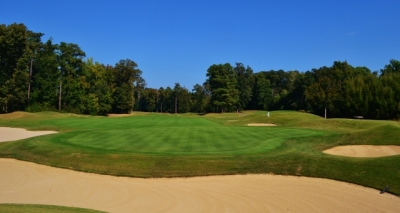 |
| From in back of the par five 5th hole -- you can see, going long isn't a great miss. |
"They basically gave me all the land I needed to fit the course in, and all the support that I could ask for in complying with the needs of building a golf course of the caliber that the Green Course is today.”
Despite the two layouts’ close approximation, they’re actually pretty different. The Green Course is longer (7120 yards to just over 6,800 for the Gold), but wider and more forgiving to a broader range of players. Winters says that once people have tried both, many come away preferring the Green Course because they don’t get the same scorecard shock that they’ll experience next door.
In addition, the Green Course utilizes roughly twice as much land (about 250 acres to 125), which results in fewer parallel fairways, and provides a sense of solitude that you won’t get as often on the Gold. Because most of the Green’s holes are bordered by trees and vegetation, that can also spell trouble for shots hit wide of the mark.
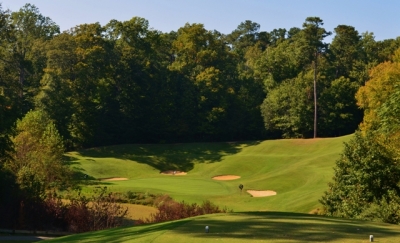 |
| The Green Course's signature par three 11th hole. The Gold Course has four beautiful par threes, but none more scenic than this one. |
There isn’t nearly as much water on the Green Course (or at least it seems that way), but you’ll still lose some golf balls if you’re hitting sideways on that particular day.
Jones explains why they used more acreage on the Green: “The Green Course is basically built on top of a series of ridges – so it plays on the high points of the property. Most of those ravines are pretty steep, so we built mounding to the sides of the holes in an attempt to contain some shots that might otherwise find trouble.”
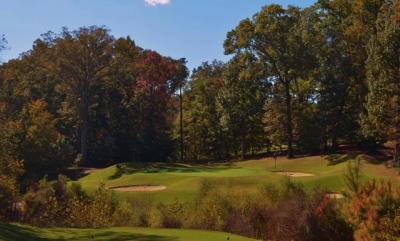 |
| Another great par three, the 7th hole. The trees frame the green perfectly. |
“The setting is extraordinary, it’s just a very natural golf course,” Jones continues. “It’s basically natural woodlands with holes cut through it. The golf course follows the flow of the land, built in the old-style classic sense, where the land dictates the strategy. Plus, it’s so peaceful and pristine while playing it -- the Green Course is like a nature walk.”
Jones says the Green Course remains one of his favorite golf projects, which is pretty high praise considering he’s worked on courses all over the world and has earned a reputation for ‘fixing’ old classic golf courses, bringing them up to modern standards – and allowing them to host many of the PGA Tour’s recent major championships.
Rees has worked on Pinehurst’s #2, as well as such notable classics as Bethpage Black, Congressional Country Club’s Blue Course and Torrey Pines’ South Course, all of which have hosted or are soon to see US Open Championships. And that’s just a partial list of ‘major’ courses to his credit.
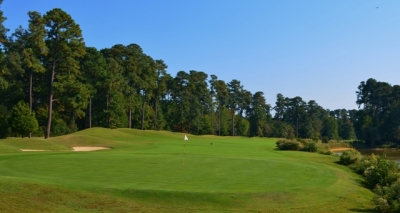 |
| The par four 14th hole is long and difficult. The landing area off the tee is very wide, but you'll need to be very accurate on your approach shot. |
The Green Course hasn’t seen the professionals tee it up in that type of event, but it still has welcomed many notable players, such as young phenom Michelle Wie during the 2004 US Women’s Public Links Championship. All who have put it to the Championship test have given it high praise – so it’s interesting to the scratch player as well as friendly to the resort player.
Jones also pointed out that the selection process for hiring an architect to design the Green Course was the most thorough investigation he’s ever been involved with. “When they’d narrowed it down to five architects, they sent a representative to each one’s office. Then they sent a group to play a course from each designer. Then they offered the architect a chance to come and play a course with them, to offer commentary on the design features.”
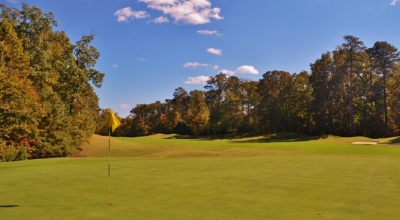 |
| The view from behind the green of the par five 8th hole. This can be one of the best birdie opportunities on the front nine if you plan your shots well.. |
“So I was able to play my designs at Haig Point (on Daufuskie Island, near Hilton Head, South Carolina) and Pinehurst #7 (in Pinehurst, North Carolina) with the Golden Horseshoe people before they selected an architect for their second championship golf course. I got a chance to show them what I thought I could do in Williamsburg, on a golf course that would sit right next to my Dad’s. That was very special,” Jones said.
“It’s something that always endears me to Colonial Williamsburg, that my Dad and I have a golf course there. It’s quite a legacy for my family,” Jones added.
Legacy seems to be the word in Williamsburg, with Virginia’s Colonial Capital the centerpiece of one of America’s most popular tourist destinations. As if the two championship golf courses at the Golden Horseshoe aren’t enough, you can spend the balance of your time seeing ‘where it all happened’ from Revolutionary times.
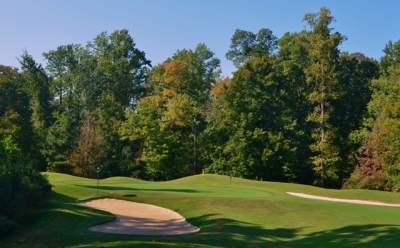 |
| The 16th hole is a short par four that doglegs sharply right off the tee -- a nice risk-reward option for people who fade the ball. |
The restored Colonial buildings aren’t the only things in good shape in Williamsburg. The Golden Horseshoe’s courses are open year-round (each course is closed one month in the winter), and thanks to its overseeded fairways and dormant Bermuda rough, remain amazingly playable, even when it’s cold outside.
Of course, during the warm months, the Bermuda grows prodigiously, providing a terrific surface where the ball really sits up – except in the rough. It’s quite a penalty to miss the fairway at the Golden Horseshoe, mainly because the superintendent does such a great job of maintaining the thickness of the rough.
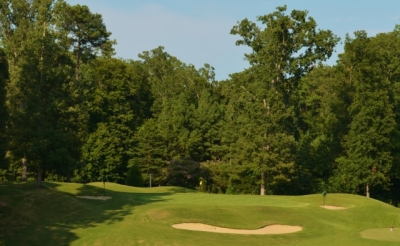 |
| It took us several tries, but we finally got a good shot of the par three 9th hole. There's a big green here, but if you miss, it'll leave quite an uphill chip. |
As mentioned earlier, the Green is wider than the Gold Course, though you’re still required to play it fairly straight. Winters says the toughest part about playing the Green Course is the need to keep the ball in play, and to avoid the sand.
The bunkering isn’t excessive, but some of them are pretty deep and can be challenging to recover from.
Thankfully, on most holes you won’t have to hit a long carry to remain on the cut grass. A couple of the par threes require carries, as do a couple of the par fives, though the lone ‘difficult’ carry is the 18th hole – and that’s only because it looks a lot longer than it is. From the back tees, it’s about a 200 yard carry – and significantly less for the white tee group. The Green Course is extremely friendly to the tee ball – something everyone appreciates.
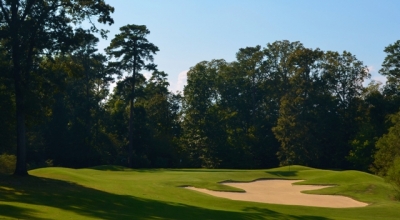 |
| At over 200 yards, the par three 17th is the toughest one-shotter on the Green Course. Word of advice: don't end up in that huge bunker on the front-right. |
The relative lack of carries also helps with pace-of-play. As is true with both of the Golden Horseshoe’s courses, they’re very well marshaled and the service is curb-to-curb. It won’t take all day to play a round there, even if you might like to stay around as long as possible – just to enjoy the atmosphere.
Hole favorites included the sixth hole, a bruising 450 yard par four, rated the Green Course’s #1 handicap hole. It looks narrow off the tee (it’s actually not that narrow), and you’ll have to fly a large grassy ‘ravine’ on your second shot. This long par four requires the dreaded duo of length and accuracy to take away a good score.
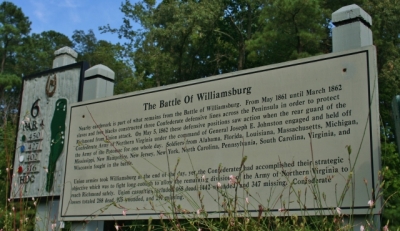 |
| History is everywhere in Colonial Williamsburg, including on the Green Course. Here, near the tee of the par four 6th hole. Photo by Kevin Gaydosh. |
The eighth hole is a very nice par five. At 538 yards, long hitters can try and reach it in two if they’re able to hit a high fade off the tee (the hole doglegs severely right). There’s also plenty of sand and grassy mounds protecting the putting surface. As is true for every great par five, the green’s much more receptive to a wedge shot than a long-iron or fairway wood, so choose your approach carefully.
The par three eleventh hole is the one you’ll remember most from the Green Course. Set in a beautiful natural amphitheater, you’re firing downhill over water to a green protected by bunkers left, right and long. Bring your camera for a shot of this one.
Eighteen is one of the best finishing holes in the Mid-Atlantic. It’s got all of the elements of a risk-reward par five – a dramatic, demanding tee shot over water, options on your second shot, and the potential to make birdie or a high number depending on how you plan it and execute. The final 2/3 of the hole plays uphill with the clubhouse as the backdrop. There’s plenty of room for spectators, and the folks having lunch on the deck have a great view of the groups coming in.
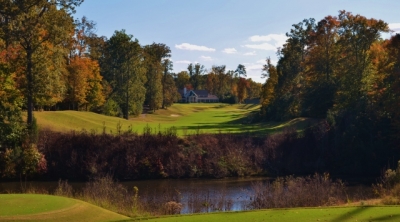 |
| One of the more dramatic finishing holes in the Mid-Atlantic, the Green Course's par five 18th hole is a birdie hole if you can blast it over the trouble off the tee. |
Having taken on the Green Course, one can’t help but think that time and word-of-mouth will bring the notoriety and respect to the Green Course that Jeff Winters and the rest of the staff seek -- and deserve.
One day soon, that the glass slipper will fit the Green Course, and it won’t be a mistake. Then there won’t be talk of being the ugly stepsister anymore.
Details:
The Golden Horseshoe Golf Club (Green Course)
Phone (757) 220-7696 FAX (757) 565-8841 Website: http://www.colonialwilliamsburg.com/do/wellness-and-recreation/golf/golf-courses/green-course/ Ambassador of Golf: Del Snyder, PGA Head Golf Professional: Jeff Winters, PGA Director of Golf: Glen Byrnes, PGA Course Designer: Rees Jones Tees/Yardage/Slope/Rating Green 7120 138/75.1 Blue 6722 134/73.4 White 6244 130/71.0; (L) 139/76.6 Red 5348 118/66.3; (L) 120/70.5 Rates: As part of Colonial Williamsburg, golf at the Golden Horseshoe is available through a number of attractive package rates, which vary depending on length of stay and type of hotel accommodations.
We suggest checking the web address above for more information.
| Related Links | Comments on this article? | |
|
Maryland National Golf Club Hollow Creek Golf Club Rocky Gap Resort PB Dye Golf Club in Ijamsville Whiskey Creek Golf Club |
E-mail Jeff Rendall, Editor: jrendall@golftheunitedstates.com |












